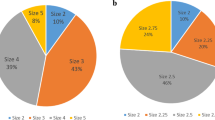Abstract
PURPOSE: This study evaluated the durability and long-term safety of radio-frequency energy delivery for fecal incontinence (Secca procedure). METHODS: This was an extended follow-up of a prospective study in which patients with fecal incontinence of various causes underwent radio-frequency energy delivery to the anal canal muscle. The Cleveland Clinic Florida Fecal Incontinence Scale (0–20), fecal incontinence–related quality-of-life score, and Medical Outcomes Study Short Form 36 were administered at baseline and at 1, 2, 3, 6, 12, and 24 months after the procedure. Differences between baseline and follow-up were analyzed with the Wilcoxon signed-rank test. RESULTS: Ten females (aged 55.9 ± 9.2 (range, 44–74) years) were treated. At two-year follow-up, the mean Cleveland Clinic Florida Fecal Incontinence Scale score was improved from 13.8 to 7.3 (P = 0.002), with eight patients having scores of ≤10. All fecal incontinence–related quality-of-life score parameters were improved, including lifestyle (from 2.3 to 3.3; P = 0.002), coping (from 1.7 to 2.7; P = 0.002), depression (from 2.4 to 3.4; P = 0.004), and embarrassment (from 1.5 to 2.4; P = 0.008). There was no decrement in effect noted in any parameter between 12 and 24 months (P > 0.2). The social function component of the Short Form 36 improved from 50 to 82.5 (P = 0.04), whereas there was an improvement trend for the mental component summary of the Short Form 36 from 38.3 to 48.1 (P = 0.11). Protective pad use was eliminated in four of the seven baseline users. There were no long-term complications, such as stricture, pain, or constipation. CONCLUSIONS: A significant improvement in symptoms of fecal incontinence and quality of life persists two years after radio-frequency delivery to the anal canal, which demonstrates durability of this intervention.
Similar content being viewed by others
References
WE Whitehead A Wald NE Diamant P Enck JH Pemberton SS Rao (1999) ArticleTitleFunctional disorders of the anus and rectum Gut 45 1155–1159
J Rothbarth WA Bemelman W Meijerink et al. (2001) ArticleTitleWhat is the impact of fecal incontinence on quality of life? Dis Colon Rectum 44 67–71
TH Rockwood JM Church JW Fleshman et al. (2000) ArticleTitleFecal incontinence quality of life scale Dis Colon Rectum 43 9–17
WE Whitehead A Wald NJ Norton (2001) ArticleTitleTreatment options for fecal incontinence Dis Colon Rectum 44 131–144
JM Jorge SD Wexner (1993) ArticleTitleEtiology and management of fecal incontinence Dis Colon Rectum 36 77–97
JS Kalantar S Howell NJ Talley (2002) ArticleTitlePrevalence of faecal incontinence and associated risk factors; an underdiagnosed problem in the Australian community? Med J Aust 176 54–57
S Perry C Shaw C McGrother et al. (2002) ArticleTitlePrevalence of faecal incontinence in adults aged 40 years or more living in the community Gut 50 480–484
W Rudolph S Galandiuk (2002) ArticleTitleA practical guide to the diagnosis and management of fecal incontinence Mayo Clin Proc 77 271–275
W Wong . The ABS Clinical Trial Group (2001) ArticleTitleThe artificial bowel sphincter—results of a multicenter clinical trial [meeting abstract] Dis Colon Rectum 44 9–275
T Takahashi S Garcia-Osogobio MA Valdovinos et al. (2002) ArticleTitleRadio-frequency energy delivery to the anal canal for the treatment of fecal incontinence Dis Colon Rectum 45 915–922
CA McHorney JE Ware JF Lu CD Sherbourne MOS The (1994) ArticleTitle36-item health survey (SF-36) Med Care 32 40–66
S Heymen KR Jones Y Ringel Y Scarlett WE Whitehead (2001) ArticleTitleBiofeedback treatment of fecal incontinence. A critical review Dis Colon Rectum 44 728–736
A Ferrara S De Jesus JT Gallagher et al. (2001) ArticleTitleTime-related decay of the benefits of biofeedback therapy Tech Coloproctol 5 131–135
R Gilliland DF Altomare H Moreira SuffixJr L Oliveira JE Gilliland SD Wexner (1998) ArticleTitlePudendal neuropathy is predictive of failure following anterior overlapping sphincteroplasty Dis Colon Rectum 41 1516–1522
AL Halverson TL Hull (2002) ArticleTitleLong-term outcome of overlapping anal sphincter repair Dis Colon Rectum 45 345–348
J Efron M Corman J Fleshman et al. (2002) ArticleTitleMulticenter, open label, prospective trial evaluating the safety and effectiveness of temperature-controlled RF energy delivery to the anal canal (Secca Procedure) for the treatment of fecal incontinence [meeting abstract] Dis Colon Rectum 45 24–348
Author information
Authors and Affiliations
About this article
Cite this article
Takahashi, T., Garcia-Osogobio, S., Valdovinos, M.A. et al. Extended Two-Year Results of Radio-Frequency Energy Delivery for the Treatment of Fecal Incontinence (the Secca Procedure). Dis Colon Rectum 46, 711–715 (2003). https://doi.org/10.1007/s10350-004-6644-8
Issue Date:
DOI: https://doi.org/10.1007/s10350-004-6644-8




